24/7 Emergency Services
Projects Complete
- 24/7 Emergency Services
- Free Estimates
- Work Directly with All Insurance Companies
- Bonded & Insured
Contents Restoration Methods in Dallas/Fort Worth Texas

As part of our contents restoration services, Dalworth Restoration uses specialized cleaning and drying methods to restore water damaged furniture, fabric, wood, leather, paper, books, photos, oil paintings, clothing, appliances documents, electronics and metal contents. These restoration methods are very effective and safe for restoring items damaged by water, mold and fire, smoke and rust. Timely response and quick action within the first 24-48 hours are crucial for best results with any contents restoration method to prevent further deterioration and mold damage.
Dalworth Restoration offers 24/7 service and immediate response. Contact us today at 817-203-2944 for a inspection and contents estimate for our contents restoration services in our Dallas-Fort Worth service area. We will visit your property, prepare an itemized contents inventory with digital images and secure and protect all of your contents and transport them to our climate-controlled contents restoration facility. We'll store your restored contents until you are ready to have them delivered.
Contents Drying Methods
Dalworth Restoration uses various drying methods to dry and restore water-damaged contents to pre-water damage condition and to prevent any additional damage like mold damage. Based on the material and the level of water damage, we select one of these drying solutions.
- Air Drying
- Cryogenic Drying (Freeze Drying)
- Vacuum Freeze-Drying
- Dehumidification Drying (Desiccant Drying)
Air Drying Method
The air drying method is ffective in drying small quantities of documents that can be dried over a large surface area and turned to expose areas of wetness or dampness. This drying method exhibits low metal corrosion.
Specialized Contents Cleaning Methods
Dalworth Restorations's water damage restroation techcnicians our tchnicians clean, sterilize, sanitize, deodorize, dry and store your contents until therestoration job is complete.
Specialized cleaning refers to various cleaning and debris removal methods applied to water-damaged contents to safely help in the water damage restoration and drying process. Our technicians pre-treat items, clean items and remove dirt and debris before drying restoration methods are performed.
Our Clean Trust Certified IICRC Restoration Crews use the following cleaning methods to restore your contents.

- Abrasive Cleaning – Scrub surface to clean and remove debris.
- Dry Cleaning – Pre-cleans prior to wet cleaning and removes light residues.
- Foam Cleaning – Cleans upholstery and fabrics; prevents shrinking and color bleeds.
- Immersion Cleaning – Water bath of contents and cleaning solution.
- Spray and Wipe – Cleans and removes debris from items that can’t be wet cleaned.
- Wet Cleaning – Removes moderate to heavy residues.
- High-Saturation Ozone Washing – Removes heavy smoke odor, soot, oil from leather, etc.
High-Saturation Ozone Washing Method
Dalworth Restoration uses high-saturation ozone washing to remove heavy smoke odor, soot or soil. This is our preferred method for cleaning leather soft goods, leather furniture and other leather contents. High-saturation ozone washing uses a gentle, specialized detergent to clean and moisturize leather by infusing oils back into the leather.
Cryogenic Drying (Freeze Drying) Method
In cryogenic drying a slight amount of moisture is retained in each item in this drying method. A short liquid state is involved, unlike the vacuum freeze-drying method (where the item is completely dried in the process). The short liquid phase has benefits when preserving paper, canvas, books and documents. This method can be more costly than other drying methods, but the restoration cost can be justified when replacing heirlooms, antiques, sentimental items, rare books, collectibles and valuable documents.
Benefits of Cryogenic Drying Method
- Less warping of books and documents
- Effective in restoring water-damaged leather & oil paintings
Vacuum Freeze-Drying Method
Vacuum freeze-drying is a very effective and safe method for preserving and restoring water damaged items, including large quantities of wet documents, books, records and coated paper and electronic components and electrical systems. We begin the drying process by completely freezing the items and then decreasing the surrounding pressure using sophisticated equipment to allow the frozen water in the contents to transition from a solid to gas, avoiding the the direct liquid to gas transition phase in ordinary drying. This direct evaporation of a solid to a vapor with no liquid phase prevents further damage during the drying restoration process restoring the components of electronics at a fraction of the cost of replacement.
Phases of Vacuum Freeze-Drying Method
- Pre-Treatment - In preparation for the freezing phase, we add components to increase stability, preserve appearance, and/or improve processing during the freezing phase.
- Freezing - We use a freeze-drying machine to freeze the material below its triple point, the lowest temperature at which the solid and liquid phases of the material can coexist to sublimate (to pass directly from the solid to the vapor state and condense back to solid form) rather than melt the ice.
- Primary Drying - Pressure is decreased with enough heat supplied through conduction to sublimate ice.
- Secondary Drying - Removes unfrozen water molecules. Residual water is reduced to 1% to 4%.
Benefits of Vacuum Freeze-Drying Method
- Gentle drying of contents at low temperatures
- Restores electronic components
- Prevents metal corrosion
- Easily dries items with large surface areas
- Restores electronics at fraction of the cost of replacement
Dehumidification Drying (Desiccant Drying)
This drying method works on the principle of adsorption with operation range from 10 °F to 90 °F. Since this drying method does not operate on the principle of heat it can be used year around in all environments. Desiccant Dehumidification dryers eliminate moisture in the plastic materials. Low drying temperatures create a low degrade of materials. This method can increase volume, cockling distortion and mold growth in paper.
Contact us today to start your contents restoration job in Dallas, Fort Worth, or Arlington and surrounding cities. We'll dispatch our contents team to your home or business in our Dallas-Fort Worth service area for a inspection and a estimate. We'll also work directly with your insurance company to file your furniture contents damage claim.













